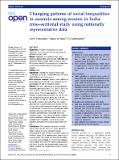| dc.contributor.author | Balarajan, Yarlini S | en_US |
| dc.contributor.author | Fawzi, Wafaie W | en_US |
| dc.contributor.author | Subramanian, S V | en_US |
| dc.date.accessioned | 2014-02-18T18:10:35Z | |
| dc.date.issued | 2013 | en_US |
| dc.identifier.citation | Balarajan, Yarlini S, Wafaie W Fawzi, and S V Subramanian. 2013. “Changing patterns of social inequalities in anaemia among women in India: cross-sectional study using nationally representative data.” BMJ Open 3 (3): e002233. doi:10.1136/bmjopen-2012-002233. http://dx.doi.org/10.1136/bmjopen-2012-002233. | en |
| dc.identifier.issn | 2044-6055 | en |
| dc.identifier.uri | http://nrs.harvard.edu/urn-3:HUL.InstRepos:11717501 | |
| dc.description.abstract | Objectives: To examine the patterns of social inequalities in anaemia over time among women of reproductive age in India. Design: Repeated cross-sectional study using nationally representative data from the 1998/1999 and 2005/2006 National Family Health Surveys of India. Multivariate modified Poisson regression models were used to assess trends and social inequalities in anaemia. Setting: India. Population 164 600 ever-married women aged 15–49 years (n=79 197 in 1998/1999 and n=85 403 in 2005/2006) from 25 Indian states. Main outcome measure Anaemia status defined by haemoglobin level (<12 g/dl in non-pregnant women, haemoglobin<11 g/dl for pregnant women). Results: Over the 7-year period, anaemia prevalence increased significantly from 51.3% (95% CI 50.6% to 52%) to 56.1% (95% CI 55.4% to 56.8%) among Indian women. This corresponded to a 1.11-fold increase in anaemia prevalence (95% CI 1.09 to 1.13) after adjustment for age and parity, and 1.08-fold increase (95% CI 1.06 to 1.10) after further adjustment for wealth, education and caste. There was marked state variation in anaemia prevalence; in only 4 of the 25 states did anaemia prevalence significantly decline. In both periods, anaemia was socially patterned, being positively associated with lower wealth status, lower education and belonging to scheduled tribes and scheduled castes. In this context of overall increasing anaemia prevalence, adjusted relative and absolute socioeconomic inequalities in anaemia by wealth, education and caste have narrowed significantly over time. Conclusions: The significant increase in anaemia among India's women during this recent period is a matter of concern, and in contrast to secular improvements in other markers of women's health and nutritional status. While socioeconomic inequalities in anaemia persist, the relative and absolute inequalities in anaemia have decreased over time. Future research should explore the causes for these changing patterns, and inform the policy and programmatic response to address anaemia and its inequalities in this vulnerable population. | en |
| dc.language.iso | en_US | en |
| dc.publisher | BMJ Group | en |
| dc.relation.isversionof | doi:10.1136/bmjopen-2012-002233 | en |
| dc.relation.hasversion | http://www.ncbi.nlm.nih.gov/pmc/articles/PMC3612779/pdf/ | en |
| dash.license | LAA | en_US |
| dc.subject | Epidemiology | en |
| dc.subject | India | en |
| dc.title | Changing patterns of social inequalities in anaemia among women in India: cross-sectional study using nationally representative data | en |
| dc.type | Journal Article | en_US |
| dc.description.version | Version of Record | en |
| dc.relation.journal | BMJ Open | en |
| dash.depositing.author | Fawzi, Wafaie W | en_US |
| dc.date.available | 2014-02-18T18:10:35Z | |
| dc.identifier.doi | 10.1136/bmjopen-2012-002233 | * |
| dash.contributor.affiliated | Fawzi, Wafaie | |


